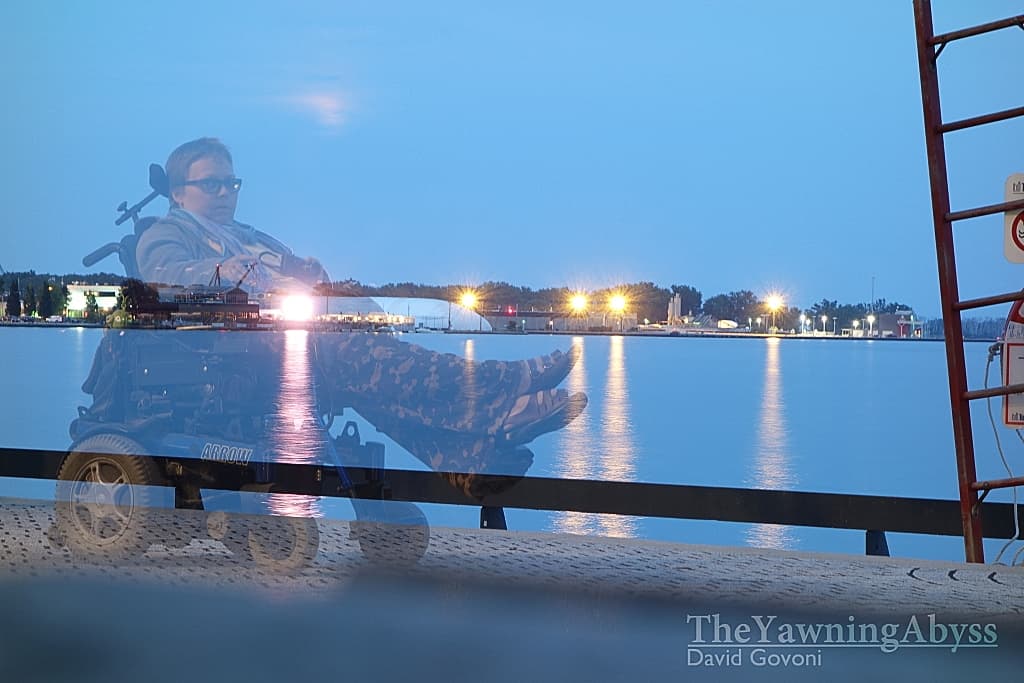Being with Lene - The Wheelchair
In which I consider the wheelchair. With a digression about a potentially miraculous grocery store.

In the past I tended not to talk or write too much about my private life. It’s just that - private. Since being with Lene I’ve become a bit more open. Giving people a peek into our overlapping lives.
Lene, in case you didn’t know, is disabled. When people find out my partner has a disability they want to know more.

Swans watching Lene review the pictures she's just taken
Take, for instance, typical discussions with coworkers. It’s more than just polite to take an interest in their lives outside the office.
Single? Married? Dating? Divorcing?
No kids and loving it? One and barely coping? “How did you cope with no sleep for so long?”. Five and it’s no big deal? All of them out of school and out of the house?
It helps to know your coworkers and what they are going through. Likewise I know that my coworkers will have a mild passing interest in what is happening in my life.
When people find out that Lene is disabled though - they want to know more and it’s not just a passing interest.

Lene amidst the light from stained glass windows
Part of it is that they wonder about how we ended up together. This is doubly true when I tell them that Lene was disabled long before I met her. They can imagine themselves in a relationship where their partner can end up with a chronic illness or disability, people do tend to take “in sickness and in health” seriously, but starting a relationship with a disabled person? They hadn’t thought of that. Most had not even considered it.
Part of it is that they wonder what it’s like being in a relationship with a disabled person. It must be different right? It can’t be just like being in any other relationship - can it? They wonder what is it like being with Lene - so they ask.
But most of the interest is simply wanting to know more about Lene and her life. What is it like to live with a disability? What are the challenges? How does she cope? What is her life like?
Without getting too personal, I answer their questions and end up talking a bit more about my private life.

Lene blazing a trail through fresh snow
Lene has written a lot about her life and her disability - you should follow her at The Seated View if you aren’t already. Still there is another perspective - mine. Which is where this series of posts comes in.
I’m going to start by talking about what makes it obvious that Lene has a disability. Her wheelchair.
Her 350 pound battery powered wheelchair.
Over the years it has been fun watching people react to Lene and her wheelchair. Most adults take it in stride and don’t pay too much attention. Children are another matter. They are fascinated.
Walking along holding mommy’s hand… they see Lene in the wheelchair and they stare. Open mouthed. They may even point. No filter between what they’re thinking and how they react. Amazement. Disbelief. Curiosity. All those and more. Even really young kids in strollers stare. Though I swear it’s because they are thinking “You mean I can use one of those when I grow up and I don’t have to do all that walking nonsense? Sign me up!”.
Most of the time the parents don’t even realize their kid is mesmerized and staring. Only occasionally do they see it and try and pull the child away to stop them from staring. Not that Lene or I mind. Nothing wrong with healthy curiousity.

Lene heading deeper into the urban forest
Even animals stare at the wheelchair. I’m not kidding. Every so often Lene and I go to the Toronto Humane Society to look at the cats up for adoption. There are cats that couldn’t care about the humans wandering in front of the cages. There are cats who want attention from those same humans. Then there are the ones that stare at Lene in her wheelchair.
They don’t stare at Lene in general. They stare at her lap. You can see them figuring it out. “It moves. A lap that moves. I can sit on it and still go places!”. Some even look her up and down - amazed that her feet don’t touch the ground. “How does she do it? How can I get me some of that!”
The answer is they can’t. Lene already has Lucy who has pride of place on the lap that floats along.

Lucy the lap cat
As you can see Lucy takes up a lot of room. Another cat wouldn’t fit.
Aside from children and the occasional cat, most people don’t look twice when they see Lene in her wheelchair. Telling someone that Lene uses a wheelchair is another matter. Especially when they find out how important the wheelchair is.
Permit me a digression. I want to tell you about one of my local grocery stores. This is relevant. I promise.
In late 2007 I moved into a new neighbourhood. One that I hadn’t lived in or even visited before. Of course I needed to check out the local grocery stores.
One of them was a few blocks away and along the bus route. Great. Easy to get to and easy to get groceries home. Perfect. I went shopping to check it out… and discovered that it may not be an ordinary grocery store.
Next to the first cashier there was the end of the large freezer that held ice cream and other frozen treats. There, 10 feet up, hanging off the top edge of the freezer where 7 or 8 canes.
Yes - canes.
I smiled as I wondered if the store was a mini-Lourdes. Could it be another Fatima? Apparently I was not only guaranteed the best price on milk and bananas - there was also the chance I could be cured.
Not every grocery store is such a miraculous place.
Later I realized the canes were probably not there for such a prosaic reason. There are any number of reasonable explanations.
- Someone using a cane hangs it on the end of their shopping cart. When they go and load up the car… they forget the cane and drive off.
- Or, after paying for their groceries, they put a few bags in each hand and walk off forgetting about their cane.
The store staff probably hung the canes up in plain sight so it was faster when someone hobbled back and asked if they had left their cane behind.
It turns out you can use a cane but not need it all the time. Many people who use mobility aids don’t need them all the time.
- The scooter makes it easier to get around the neighbourhood but the person can still walk on their own.
- The cane helps keep someone steady but they can walk short distances without it.
- Someone uses a wheelchair but can get themselves in and out of it without any help.
They are all optional tools. They make life easier but they don’t need to be used all the time.

Lene being chased by a film crew on a dolly
In Lene’s case her power wheelchair isn’t optional. She can’t push herself around in a manual chair. She can’t stand or walk on her own. She can’t even get into or out of her chair without some help. Not much help mind you - it’s a simple transfer. She does most of the work and she can support her weight - it’s more about guiding her into or out of the chair.
When people hear that Lene uses and depends on a wheelchair I can see the pity building up. “Oh the poor thing.”
They can’t imagine needing a wheelchair to get around. How horrible. They wouldn’t want to live like that. And on and on. People think that disability is the end of living. That, if it happened to them, they wouldn’t want to live. Lene must be so courageous.
Wrong. Completely wrong. That’s not it at all.
The idea that you wouldn’t want to live with a disability is simply short sighted and stupid. Yet we end up with movies like Million Dollar Baby. A movie not much loved by the disabled community. In which a character would rather die than continue to live with a disability. Lene has written about the “I’d rather die” trope more than once.
People just quickly assume that being in a wheelchair is bad. It’s a knee jerk reaction. I think it’s more that they haven’t tried to think about needing a wheelchair all the time.

Lene walking through a snowy cloud atop the CN Tower
That way of looking at things is completely wrong. She isn’t wheelchair bound at all. Nor is she confined to a wheelchair. Quite the opposite.
Lene has written about what the wheelchair is to her… how getting one changed her life. Download and read Unbound from her site for the full story.
See - If she didn’t have the wheelchair - she would be stuck in bed. Or, at best, in a manual chair waiting for someone to move her wherever she wants to go.
Her chair is freedom and independence.

Lene at Tommy Thompson Park
Not much stands in her way. As long as the path is smooth nothing will stop her. Except maybe inaccessible buildings and sidewalks with no curb cuts.

Lene on the Toronto Islands
Boardwalks, cobblestones, and other bumpy surfaces are a bit of a problem.

Lene on the Island boardwalk
Driving over those for extended periods of time adds to her pain levels.
Otherwise - look out. She’s on a roll. Her wheelchair is not a problem. It’s her legs. Without it she wouldn’t get anywhere. With it… she’s practically unstoppable.
So much so that I have problems keeping up even before she engages turbo mode. As you can see, from the sampling of photos in this post, I’m almost always behind and trying to catch up. I have many pictures of the back of her wheelchair.
Her wheelchair doesn’t hold her back at all.
If she didn’t keep stopping to take pictures I’d never keep up.

Lene stopping to take a picture
Next time you see someone in a wheelchair - remember Lene. Don’t feel sorry for the person. Don’t feel pity. A wheelchair isn’t always a curse. It’s more likely to be a blessing.
